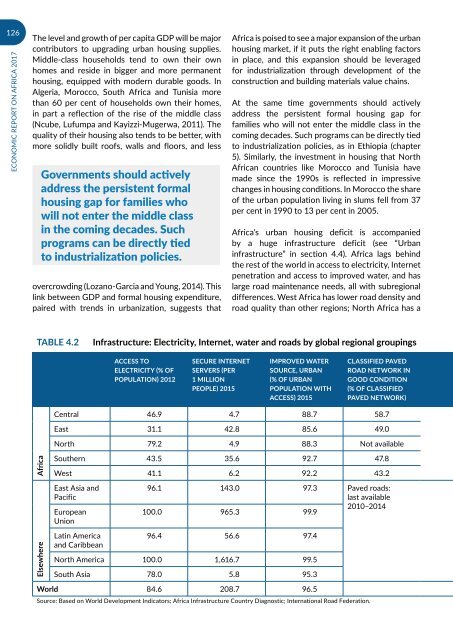URBANIZATION AND INDUSTRIALIZATION
Economic%20Report%20on%20Africa%202017%20UNECA
Economic%20Report%20on%20Africa%202017%20UNECA
Create successful ePaper yourself
Turn your PDF publications into a flip-book with our unique Google optimized e-Paper software.
126<br />
ECONOMIC REPORT ON AFRICA 2017<br />
The level and growth of per capita GDP will be major<br />
contributors to upgrading urban housing supplies.<br />
Middle-class households tend to own their own<br />
homes and reside in bigger and more permanent<br />
housing, equipped with modern durable goods. In<br />
Algeria, Morocco, South Africa and Tunisia more<br />
than 60 per cent of households own their homes,<br />
in part a reflection of the rise of the middle class<br />
(Ncube, Lufumpa and Kayizzi-Mugerwa, 2011). The<br />
quality of their housing also tends to be better, with<br />
more solidly built roofs, walls and floors, and less<br />
Governments should actively<br />
address the persistent formal<br />
housing gap for families who<br />
will not enter the middle class<br />
in the coming decades. Such<br />
programs can be directly tied<br />
to industrialization policies.<br />
overcrowding (Lozano-Garcia and Young, 2014). This<br />
link between GDP and formal housing expenditure,<br />
paired with trends in urbanization, suggests that<br />
Africa is poised to see a major expansion of the urban<br />
housing market, if it puts the right enabling factors<br />
in place, and this expansion should be leveraged<br />
for industrialization through development of the<br />
construction and building materials value chains.<br />
At the same time governments should actively<br />
address the persistent formal housing gap for<br />
families who will not enter the middle class in the<br />
coming decades. Such programs can be directly tied<br />
to industrialization policies, as in Ethiopia (chapter<br />
5). Similarly, the investment in housing that North<br />
African countries like Morocco and Tunisia have<br />
made since the 1990s is reflected in impressive<br />
changes in housing conditions. In Morocco the share<br />
of the urban population living in slums fell from 37<br />
per cent in 1990 to 13 per cent in 2005.<br />
Africa’s urban housing deficit is accompanied<br />
by a huge infrastructure deficit (see “Urban<br />
infrastructure” in section 4.4). Africa lags behind<br />
the rest of the world in access to electricity, Internet<br />
penetration and access to improved water, and has<br />
large road maintenance needs, all with subregional<br />
differences. West Africa has lower road density and<br />
road quality than other regions; North Africa has a<br />
Table 4.2<br />
Infrastructure: Electricity, Internet, water and roads by global regional groupings<br />
ACCESS TO<br />
ELECTRICITY (% OF<br />
POPULATION) 2012<br />
SECURE INTERNET<br />
SERVERS (PER<br />
1 MILLION<br />
PEOPLE) 2015<br />
IMPROVED WATER<br />
SOURCE, URBAN<br />
(% OF URBAN<br />
POPULATION WITH<br />
ACCESS) 2015<br />
CLASSIFIED PAVED<br />
ROAD NETWORK IN<br />
GOOD CONDITION<br />
(% OF CLASSIFIED<br />
PAVED NETWORK)<br />
Central 46.9 4.7 88.7 58.7<br />
East 31.1 42.8 85.6 49.0<br />
North 79.2 4.9 88.3 Not available<br />
Africa<br />
Southern 43.5 35.6 92.7 47.8<br />
West 41.1 6.2 92.2 43.2<br />
East Asia and<br />
Pacific<br />
European<br />
Union<br />
96.1 143.0 97.3 Paved roads:<br />
last available<br />
100.0 965.3 99.9<br />
2010–2014<br />
Elsewhere<br />
Latin America<br />
and Caribbean<br />
96.4 56.6 97.4<br />
North America 100.0 1,616.7 99.5<br />
South Asia 78.0 5.8 95.3<br />
World 84.6 208.7 96.5<br />
Source: Based on World Development Indicators; Africa Infrastructure Country Diagnostic; International Road Federation.


